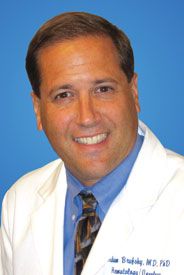Article
Brufsky Discusses Biosimilar Breakthroughs and Challenges
Author(s):
Adam Brufsky, MD, PhD, comments the FDA approval of MYL-1401O and discusses the adoption of biosimilars in oncology.
Adam M. Brufsky, MD, PhD

Adam M. Brufsky, MD, PhD
In December 2017, the FDA approved the trastuzumab (Herceptin) biosimilar MYL-1401O (Ogivri; trastuzumab-dkst) for patients with HER2-positive breast cancer, as well as metastatic gastric or gastroesophageal junction adenocarcinoma.
However, the adoption of biosimilars has been slow for some physicians, as there has not been a compelling enough reason to choose them over the originator drug, says Adam Brufsky, MD, PhD. If payers can demonstrate that using a biosimilar will result in a significant reduction in cost, then biosimilars may become more appealing, he adds.
The biologics license application for MYL-1401O, submitted in November 2016, cited phase III results from the HERiTAge study. This was a 2-part, multicenter, double-blind, randomized, parallel-group study of patients with measurable HER2-positive metastatic breast cancer who had not received prior chemotherapy or trastuzumab. MYL-1401O demonstrated an overall response rate (ORR) of 69.6% after 24 weeks among women who received MYL-1401O in combination with a taxane compared with a 64% ORR for patients who took trastuzumab plus a taxane. Additionally, the progression-free survival (PFS) was similar in the 2 groups (stratified HR, 0.95; 95% CI, 0.71-1.25).
Codeveloped by Mylan and Biocon, MYL-1401O is approved for the same indications as trastuzumab; however, Genentech, the manufacturer of trastuzumab, holds an exclusive license at this time for the metastatic gastric cancer indication.
OncLive: Can you provide some background on the HERiTAge study?
In an interview with OncLive, Brufsky, professor of medicine, associate chief, Division of Hematology/Oncology, co-director, Comprehensive Breast Cancer Center, associate director, Clinical Investigation, University of Pittsburgh, commented on the FDA approval of MYL-1401O and discussed the adoption of biosimilars in oncology.Brufsky: The idea behind a biosimilar is that is it similar; it is not superior and it is not inferior. It is very important to understand that. That means, before a biosimilar even gets to a clinical trial, there has to be protein assays, protein electrophoreses, and glycosylation assays that show similarity to the originator compound. All of that has to be done before it gets to human beings. Once you get to human beings, within a confidence interval, it has to show that it is similar—it cannot be inferior or superior. In fact, one biosimilar did not get an approval because it was superior. It is very important to be within the confidence interval.
Are biosimilars being prescribed yet?
If a biosimilar proves to be superior in a trial, what are the next steps?
What other biosimilars are being explored?
Do you envision that at some point, the role of originator trastuzumab will change?
What other major challenges or questions remain with biosimilars?
The HERiTAge trial looked at ORR in metastatic breast cancer. With HERiTAge, [MYL-1401O] was within the confidence interval. It was within the odds ratio of the confidence interval for PFS. This is what led to the approval of the HER2-based biosimilar. And that is fine, it is not a problem—it’s another drug. The issue with biosimilars in general is going to be proving the advantage in using them. The obvious one is cost—and we all want the cost of pharmaceuticals to come down—but it needs to be a substantial percentage. There must be some cost differentials for people to want us to use biosimilars because physicians will probably choose the agent that they are more familiar with.Not [MYL-1401O], because it isn't available yet. People have more experience with the biosimilar for the G-CSF analog Zarxio (filgrastim-sndz), because payers require the use of that biosimilar. I don't have a problem if a payer tells me to do it, but the payer needs to demonstrate to me that there is really a benefit, not because someone took them out to dinner—but because there is actually a cost benefit to the compound. If there is no cost benefit, there is no reason for me to use it.The investigators have to do a whole new trial from scratch, and the FDA requires it to be a different pathway. The biosimilarity pathway is one pathway that requires certain things, but then you have to do a phase III trial against the standard of care where the statistics are totally different.There is a biosimilar for bevacizumab (Avastin) in breast cancer, there is a biosimilar for rituximab for lymphoma, and there is a biosimilar for a pegylated G-CSF analog (pegfilgrastim) [under review]. Those are the big ones coming down the pike soon, but there are a lot of other compounds that people are talking about. With trastuzumab, they are trying different formulations. Subcutaneous trastuzumab has the advantage of being able to be given at home with an injector, and it’s quicker. That kind of formulation is very popular outside of the United States. There is not a lot; we just don’t know the long-term side effects and benefits. There is always an unknown. They are as similar as they can be based on the technology available in 2018. The problem is that biologics are incredibly complicated, so as a result, it is only as good as what we have—there may be some long-term difference in side effects or efficacy, we just don't know. It could happen; I doubt it, but it could happen.






%20(2)%201-Recovered-Recovered-Recovered-Recovered-Recovered.jpg?fit=crop&auto=format)

%20(2)%201-Recovered-Recovered-Recovered-Recovered-Recovered.jpg?fit=crop&auto=format)
%20(2)%201-Recovered-Recovered-Recovered-Recovered-Recovered.jpg?fit=crop&auto=format)